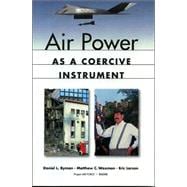
Note: Supplemental materials are not guaranteed with Rental or Used book purchases.
Purchase Benefits
What is included with this book?
| Preface | p. iii |
| Figures | p. ix |
| Table | p. xi |
| Summary | p. xiii |
| Acknowledgments | p. xvii |
| Introduction | p. 1 |
| Definitions and Theory | p. 7 |
| How to Think about Coercion | p. 9 |
| Successful Coercive Diplomacy: Lessons from the Past | p. 27 |
| Explaining Success or Failure: The Historical Record | p. 29 |
| Coercive Diplomacy Today | p. 57 |
| Domestic Constraints on Coercion | p. 59 |
| Coercion and Coalitions | p. 87 |
| Coercing Nonstate Actors: a Challenge for the Future | p. 107 |
| Coercion and the U.S. Air Force | p. 127 |
| Implications and Recommendations for the USAF | p. 129 |
| Cases Examined in This Study | p. 141 |
| Cases and Conditions for Success | p. 149 |
| Coercive Attempts and Common Challenges | p. 155 |
| Bibliography | p. 161 |
| Table of Contents provided by Publisher. All Rights Reserved. |
The New copy of this book will include any supplemental materials advertised. Please check the title of the book to determine if it should include any access cards, study guides, lab manuals, CDs, etc.
The Used, Rental and eBook copies of this book are not guaranteed to include any supplemental materials. Typically, only the book itself is included. This is true even if the title states it includes any access cards, study guides, lab manuals, CDs, etc.